|
|
|
Sort Order |
|
|
|
Items / Page
|
|
|
|
|
|
|
| Srl | Item |
| 1 |
ID:
126015


|
|
|
|
|
| Publication |
2013.
|
| Summary/Abstract |
Before the 1990s, very little research had been done on the religious dimension in the dynamics of internal and international violent conflicts. Two factors may explain this: first, the lack of interest of a good part of international theory in peace research and conflict resolution in particular; and, second, the negative impact of the division between the major disciplines of social sciences and area studies. This article takes this insufficiency as its starting point and assumes that the factors of greatest value in explaining violent conflict are diverse (political, economic or social processes), and to speak of a single factor (religion) in isolation makes little sense if it is not contextualized within a metatheory. Thus, the article presents several elements that are derived from the theory of conflict resolution and area studies on the Middle East and North Africa region, and which should be taken into consideration when examining the extent to which religion contributes to violent conflicts and their evolution.
|
|
|
|
|
|
|
|
|
|
|
|
|
|
|
|
| 2 |
ID:
126018
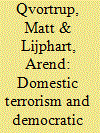

|
|
|
|
|
| Publication |
2013.
|
| Summary/Abstract |
Using logistic regression on the 36 democracies studied in Lijphart's Patterns of Democracy, we find statistically significant correlations between the index of consensus democracy and a higher incidence of fatal domestic terror incidents in the period 1985-2010. We further find that the risk of fatal terrorist attacks is almost six times higher in majoritarian democracies than in their consensus counterparts, and that this indicator is stronger than factors such as economic development and a large youth population and levels of urbanisation.
|
|
|
|
|
|
|
|
|
|
|
|
|
|
|
|
| 3 |
ID:
126021


|
|
|
|
|
| Publication |
2013.
|
| Summary/Abstract |
Theoretically, variation in leadership preferences is often taken to be an important predictor of ethno-territorial conflict outcomes. Yet there is a significant gap when it comes to applying this theory. Case studies do not take a consistent approach to measuring leadership preferences, while statistical research tends to omit the variable altogether. This paper suggests a standardized approach to measuring leadership preferences along two dimensions - a dimension that captures the weight given to achieving ideal nationalist goals as against minimizing conflict costs and downside conflict risks, and a dimension that indicates how much intrinsic nationalist goals are valued relative to the goal of taking and maintaining political power. The resulting measurement template is then applied to seven potential ethno-territorial conflicts in Yugoslavia in the early 1990s. These cases indicate that leadership preferences may help to explain ethno-territorial conflict outcomes and, at the same time, are sometimes not well predicted by other important variables, such as the balance of power and the pre-conflict status quo.
|
|
|
|
|
|
|
|
|
|
|
|
|
|
|
|
| 4 |
ID:
126013
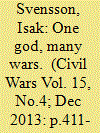

|
|
|
|
|
| Publication |
2013.
|
| Summary/Abstract |
This paper examines the religious dimensions of armed conflicts in the Middle East and North Africa (MENA), a region where the monotheistic religions of Judaism, Islam, and Christianity traditionally dominate. Applying a regional perspective, this study finds that about half of the armed conflicts in the MENA region were between parties, where at least one side had made explicit reference to religion in their basic demands, and this category of conflicts has increased substantially over time. Why are religious civil wars becoming relatively more common over time in the MENA region? I argue that the relatively high frequency of religious armed intrastate conflicts in the region can be explained by three major empirical regularities: (1) the intractability of interreligious conflicts; (2) the spread of several but relatively shorter intrareligious disputes; and (3) the increasingly transnational aspect of religious disputes in the MENA region. Although these trends have been countered by the emergence of institutional settlements of some of the armed conflicts, these types of conflict management and conflict resolution attempts have, so far, been too few to generate a general shift in the basic empirical patterns. This paper provides an empirical overview over the main patterns and ends by identifying some important avenues for future research.
|
|
|
|
|
|
|
|
|
|
|
|
|
|
|
|
| 5 |
ID:
126012
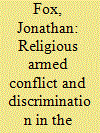

|
|
|
|
|
| Publication |
2013.
|
| Summary/Abstract |
The role of religion in armed conflict and discrimination in the Middle East and North Africa (MENA) is receiving increased attention as the focus of the region's conflicts shifts from nationalism and ethnicity to religion. All of the contributions to this section seek to build knowledge and theories to understand how religion contributes to conflict and discrimination, focusing on the MENA, the world region where religious conflict and discrimination are most prominent. The three articles in this special section of Civil Wars address these changes, each looking at them from a unique perspective including both comparative and quantitative methodology.
|
|
|
|
|
|
|
|
|
|
|
|
|
|
|
|
| 6 |
ID:
126017
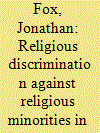

|
|
|
|
|
| Publication |
2013.
|
| Summary/Abstract |
This study examines religious discrimination between 1990 and 2008 against 47 religious minorities in 17 Middle Eastern Muslim majority states using data from the Religion and State-Minorities data-set. The study uses a 29-category variable which measures restrictions on the religious practices or institutions of minority religions which are not placed on the majority religion. Forty-five of the 47 minorities, including all non-Muslim minorities, experience religious discrimination. Discrimination is lowest but still substantial against Muslim minorities (e.g. Shi'i Muslims in a Sunni Muslim state), higher against Christians, but highest against Hindus, Buddhists, Druze, and Bahai. Twenty-eight of the 29 types of religious discrimination included in the data-set are present in the region. Finally, when discounting the removal of Saddam Hussein's regime from Iraq, religious discrimination in the region remains stable.
|
|
|
|
|
|
|
|
|
|
|
|
|
|
|
|
| 7 |
ID:
126020


|
|
|
|
|
| Publication |
2013.
|
| Summary/Abstract |
Despite the frequent failure of mediation efforts, the potential negative impact of this outcome on conflict dynamics in civil wars has not been systematically studied. Starting from the assumption that the failure of mediation may cause the conflict parties to conclude that non-violent strategies are ineffective, we develop a rationalist model to explain under what conditions mediation failure might lead to the escalation of violence. Shifts in the degree of negotiability of the conflict parties' goals and in the balance of their internal structure (relative strength of hardliners and moderates) are taken as explanatory variables. We test our hypotheses with a qualitative comparison of 23 cases of failed civil war mediation from around the globe. While shifting goals are rarely observed, it is shown how the strengthening of hardliners in the wake of mediation failure has significant explanatory power.
|
|
|
|
|
|
|
|
|
|
|
|
|
|
|
|
| 8 |
ID:
126022
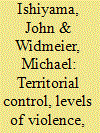

|
|
|
|
|
| Publication |
2013.
|
| Summary/Abstract |
This paper explores debates about electoral patterns in post-civil war societies. In particular, we examine whether the ability of rebels to capture and control territory and the level of violence at the local level explains the electoral performance of former rebel political parties, focusing on the Islamic Renaissance Party of Tajikstan (IRPT) and the Communist Party of Nepal (Maoist) (CPN (M)). Using data from the 2000 legislative election in Tajikistan and the 2008 Nepalese Constituent Assembly election, this paper finds that rebel control over districts did explain rebel party's electoral performance in Nepal. However, rebel control of districts in Tajikistan during the civil war did not predict the electoral performance in the first post-conflict election in that country. This is largely due to the disconnect between the IRPT and the constituencies that had supported it during the civil war, and because the level of control that the party exerted was far less than that of the CPN (M).
|
|
|
|
|
|
|
|
|
|
|
|
|
|
|
|
| 9 |
ID:
126023


|
|
|
|
|
| Publication |
2013.
|
| Summary/Abstract |
In their text published in May 2012, Bruno Reis and Pedro Oliveira proposed six theses on the massacre at Wiriyamu. They claim or imply that as a location of well-developed villages Wiriyamu did not exist; the massacre as reported might not have happened; although an atrocity may have occurred, the events are too complex to accurately unravel even today; lack of an independent or official inquiry makes the numbers of the dead as reported inaccurate; and that the exigencies of the counterinsurgency determined its context and magnitude within the framework of a civil war. This response examines these six theses, and concludes that Reis and Oliveira fail to advance the narrative. They accept at face value the Portuguese propaganda denying the existence of Wiriyamu as a place, rather than consider data that incontrovertibly proved the existence of Wiriyamu, the massacre, its context, and the overall integrity of the narrative. Finally this text sends a mixed message to its readers by contextualizing it as a case study in civil war.
|
|
|
|
|
|
|
|
|
|
|
|
|
|
|
|
|
|
|
|
|